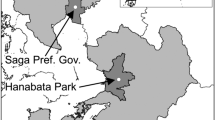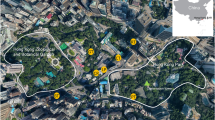Abstract
Avian time–activity budgets are known to be affected by many environmental factors. The aim of this study was to examine whether roosting times of common ravens Corvus corax are affected by inclement weather conditions in response to increased energy demands. The study was conducted at a communal roost of ravens in Thuringia, Germany, from August 2003 to January 2005. The number of roosting ravens fluctuated substantially, ranging from zero individuals in summer to 574 in winter. During the entire study period, a composting facility served as the main feeding ground for roosting ravens. There, the feeding-to-resting ratio did not depend on flock size, indicating the ravens were not food limited. Ravens arrived at the preroost and the roost later relative to sunset on cloudless evenings and on days with shorter length of daylight. Weather conditions measured as ambient temperature, wind speed, and cumulative daily precipitation had no effect on arrival times at the preroost and the roost. Likewise, moonlight did not affect roosting times. Apparently, flexible time–activity budgets resulting from a superabundant food supply may have enabled ravens to moderate the effects of environmental conditions on arrival times at the preroost and the roost.




Similar content being viewed by others
References
Alonso JA, Alonso JC, Veiga JP (1985) The influence of moonlight on the timing of roosting flights in Common Cranes Grus grus. Ornis Scand 16:314–318
Aschoff J (1960) Exogenous and endogenous components in circadian rhythms. In: Cold Spring Harbor symposia on quantitative biology, vol 25. Cold Spring Harbor Press, New York, pp 11–28
Aschoff J, Wever R (1962) Beginn und Ende der täglichen Aktivität freilebender Vögel. J Ornithol 103:2–27
Barmettler A (2005) CalSky—the astronomical calendar. (Available from http://www.calsky.com/cs.cgi/Moon/)
Beauchamp G (1999) The evolution of communal roosting in birds: origin and secondary losses. Behav Ecol 10:675–687
Brandstätter R (2002) The circadian pacemaking system of birds. In: Kumar V (ed) Biological rhythms. Narosa Publishing House, New Delhi, pp 144–163
Brodsky LM, Weatherhead PJ (1984) Behavioural thermoregulation in wintering Black Ducks: roosting and resting. Can J Zool 62:1223–1226
Caccamise DF, Morrioson DW (1986) Avian communal roosting: implications of diurnal activity centers. Am Nat 128:191–198
Cuthill IC, Houston AI (1997) Managing time and energy. In: Krebs JR, Davis NB (eds) Behavioural ecology: an evolutionary approach, 4th edn. Blackwell Science, Oxford, pp 97–120
Daan S, Aschoff J (1975) Circadian rhythms of locomotor activity in captive birds and mammals: Their variations with season and latitude. Oecologia 18:269–316
Dall SRX (2002) Can information sharing explain recruitment to food from communal roosts? Behav Ecol 13:42–51
Davis GJ, Lussenhop JF (1970) Roosting of Starlings (Sturnus vulgaris): a function of light and time. Anim Behav 18:362–365
Doucette DR, Reebs SG (1994) Influence of temperature and other factors on the daily roosting times of Mourning Doves in winter. Can J Zool 72:1287–1290
Eisenbart M (2003) NauticTools, 1.20, Kirchenlengern
Eiserer LA (1984) Communal roosting in birds. Bird Behav 5:61–80
Elkins N (1988) Weather and bird behaviour, 2nd edn. T & A D Poyser, Calton
Engel KA, Young LS (1989) Spatial and temporal patterns in the diet of Common ravens in southwestern Idaho. Condor 91:372–378
Engel KA, Young LS (1992) Daily and seasonal activity patterns of Common ravens in southwestern Idaho. Wilson Bull 104:462–471
Engel KA, Young LS, Steenhof K, Roppe JA, Kochert MN (1992) Communal roosting of Common ravens in southwestern Idaho. Wilson Bull 104:105–121
Everding SE, Jones DN (2006) Communal roosting in a suburban population of Torresian Crows (Corvus orru). Landsc Urban Plan 74:21–33
Graham MH (2003) Confronting multicollinearity in ecological multiple regressions. Ecology 84:2809–2815
Gwinner E (1975) Circadian and circannual rhythms in birds. In: Farner DS, King JR, Parkers KC (eds) Avian biology, vol 5. Academic, London, pp 221–285
Hansen H, Smedshaug CA, Sonerud GA (2000) Preroosting behaviour of Hooded Crows (Corvus corone cornix). Can J Zool 78:1813–1821
Heinrich B (1988) Winter foraging at carcasses by three sympatric corvids, with emphasis on recruitment by the raven, Corvus corax. Behav Ecol Sociobiol 23:141–156
Herbers JM (1981) Time resources and laziness in animals. Oecologia 49:252–262
Holmgren J (2004) Roosting in tree foliage by Common Swifts Apus apus. Ibis 146:404–416
Jacquet J-M, Launay F (1997) Diurnal behavioural patterns in the Houbara Bustard (Chlamydotis undulata) in captivity: effects of temperature and daylength. Appl Anim Behav Sci 55:137–151
Jumber JF (1956) Roosting behavior of the Starling in central Pennsylvania. Auk 73:411–426
Krantz PE, Gauthreaux SA (1975) Solar radiation, light intensity, and roosting behavior in birds. Wilson Bull 87:91–95
Lopez-Calleja MV, Bozinovic F (2003) Dynamic energy and time budgets in hummingbirds: a study in Sephanoides sephaniodes. Comp Biochem Phys A 134:283–295
Madge S, Burn H (1994) Crows and jays. Christopher Helm, London
Marzluff JM, Heinrich B, Marzluff CS (1996) raven roosts are mobile information centers. Anim Behav 51:89–103
Moore JE, Switzer PV (1998) Preroosting aggregations in the American Crow, Corvus brachyrhyncos. Can J Zool 76:508–512
Morse DH (1980) Behavioral mechanisms in ecology. Harvard University Press, Cambridge
Nogales M, Hernnandez EC, Valdes F (1997) Diet of Common ravens on El Hierro, Canary Islands. J Field Ornithol 68:382–391
Peh KSH (2002) Roosting behaviour of House Crow (Corvus splendens) in relation to environmental variables. Raffles B Zool 50:257–262
Perlmutter GB (1992) Environmental factors influencing roost arrival of Black-crowned Night-herons. J Field Ornithol 63:462–465
Raveling DG, Crews WE, Klimstra WD (1972) Activity patterns of Canada Geese during winter. Wilson Bull 84:278–295
Reebs SG (1986) Influence of temperature and other factors on the daily roosting times of black-billed Magpies. Can J Zool 64:1614–1619
Restani M, Marzluff JM, Yates RE (2001) Effects of anthropogenic food sources on movements, survivorship, and sociality of Common ravens in the Arctic. Condor 103:399–404
Richner H, Heeb P (1995) Is the information center hypothesis a flop? Adv Stud Behav 24:1–45
Rösner S, Selva N, Müller T, Pugacewicz E, Laudet F (2005) raven Corvus corax ecology in a primeval temperate forest. In: Jerzak L, Kavanagh BP, Tryjanowski P (eds) Ptaki krukowate Polski [Corvids of Poland]. Bogucki Wyd. Nauk., Poznan, pp 385–405
Rusak B (1981) Vertebrate behavioral rhythms. In: Aschoff J (ed) Handbook of behavioral neurobiology, vol 4. Plenum Press, New York, pp 183–213
Sarà M, Busalacchi B (2003) Diet and feeding habits of nesting and non-nesting ravens (Corvus corax) on a Mediterranean island (Vulcano, Eolian archipelago). Ethol Ecol Evol 15:119–131
Sonerud GA, Smedshaug CA, Brathen O (2001) Ignorant Hooded Crows follow knowledgeable roost-mates to food: support for the information centre hypothesis. Proc R Soc Lond B 268:827–831
Swingland IR (1976) The influence of light intensity on the roosting times of the Rook (Corvus frugilegus). Anim Behav 24:154–158
Tieleman BI, Williams JB, Visser GH (2003) Variation in allocation of time, water and energy in Hoopoe Larks from the Arabian Desert. Funct Ecol 17:869–876
Warkentin IG (1986) Factors affecting roost departure and entry by wintering Merlins. Can J Zool 64:1317–1319
Wright J, Stone RE, Brown N (2003) Communal roosts as structured information centres in the raven, Corvus corax. J Anim Ecol 72:1003–1014
Zammuto RM, Franks EC (1981) Environmental effects on roosting behavior of Chimney Swifts. Wilson Bull 93:77–84
Acknowledgements
We are grateful to Katharina Bóth for initial impulses in the development of the study and Steffen Hahn, Tim Nuttle, Simone Pfeiffer, Markus Ritz, Sascha Rösner, and three anonymous referees for valuable comments. For field assistance we thank Benjamin Herold, Stephanie Rapp, and Ulrike Raum. Meteorological data was kindly provided by Jens Schumacher and Wolfgang W. Weisser.
Author information
Authors and Affiliations
Corresponding author
About this article
Cite this article
Janicke, T., Chakarov, N. Effect of weather conditions on the communal roosting behaviour of common ravens Corvus corax with unlimited food resources. J Ethol 25, 71–78 (2007). https://doi.org/10.1007/s10164-006-0209-3
Received:
Accepted:
Published:
Issue Date:
DOI: https://doi.org/10.1007/s10164-006-0209-3




